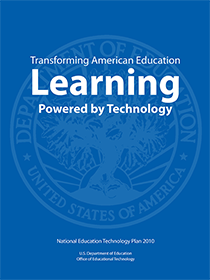I
According to U.S. Secretary of Education Arne Duncan, “the plan’s development was led by the Department of Education’s Office of Educational Technology and involved the most rigorous and inclusive process ever undertaken for a national education technology plan.” It received input from education researchers, hundreds of technology industry experts, thousands of educators, and the public.
This is the first of several posts discussing the various goals and recommendations of this plan for promoting technology in the classroom. In this post, we’ll provide a paraphrased summary of the plan’s recommendations.
Goal 1 – Learning: Engage and Empower
All learners will have engaging and empowering learning experiences both in and out of school that prepare them to be active, creative, knowledgeable, and ethical participants in our globally networked society.
- This first goal urges states and districts to develop standards and resources with technology in mind. See the chart above (Figure 1) of A Model of Learning, Powered by Technology. In this model, technology supports learning by providing engaging environments and tools for understanding and remembering content.
- In addition, these resources should build on what’s been learned from science about factual knowledge, procedural knowledge, and motivational engagement.
- The report recommends making learning experiences available anytime and anywhere through the always-on nature of the Internet and mobile access devices.
- Finally, this goal urges the adoption of new methodologies to inspire and enable all learners to excel in STEM (science, technology, engineering, and mathematics).
Goal 2 – Assessment: Measure What Matters
Our education system at all levels will leverage the power of technology to measure what matters and use assessment data for continuous improvement.
- This goal urges states and districts to use technology to develop assessments that can give “timely and actionable” feedback about learning.
- It also urges the development of new types of assessments that can measure performance in ways that we cannot currently measure.
- It suggests that interactive technologies, such as simulations, collaboration environments, virtual worlds, games, and cognitive tutors, can be used to engage students more effectively. These technologies work because they give immediate embedded assessment or feedback.
- The goal recommends the development of assessment design tools that can measure intended qualities with appropriate features – not with just accommodations for the disabled or those with extra abilities.
- The goal recommends the development of a lifelong electronic learning record with appropriate safeguards for privacy.
Goal 3 – Teaching: Prepare and Connect
Professional educators will be supported individually and in teams by technology that connects them to data, content, resources, expertise, and learning experiences that enable and inspire more effective teaching for all learners.
- Educators should be able to tap resources across the world for discussing best practices with other educators or for expanding the learning opportunities for students.
- Educators should be able to use social networks to create communities of practice for lifelong learning and collaborative development of resources.
- Online learning options should be provided to serve students in rural areas, to help those with special needs, or to tap specialty experts, such as STEM.
- Technology should be used for training and ongoing learning by teachers to build their digital literacy.
Goal 4 – Infrastructure: Access and Enable
All students and educators will have access to a comprehensive infrastructure for learning when and where they need it.
- It is recommended that students and educators have broadband access to the Internet and adequate wireless connectivity both in and out of school.
- Every student and educator should have at least one Internet access device and appropriate software and resources for use in and out of school. These can be owned by the student, his family, the school, or some combination.
- Support the development and adoption of open educational resources to motivate innovation and creativity.
- Support state and local efforts to transition to professionally managed data centers in the cloud for greater efficiency and flexibility.
- Support the development of “interoperability” standards so content, resources, and data can be leveraged across platforms and systems.
- Similar “interoperability” standards should also be implemented for financial data of the schools.
Goal 5 – Productivity: Redesign and Transform
Our education system at all levels will redesign processes and structures to take advantage of the power of technology to improve learning outcomes while making more efficient use of time, money, and staff.
- Develop and adopt a common definition of productivity in education, and methods for managing costs.
- Rethink basic assumptions that inhibit using technology to improve learning, such as organizing around seat time, age groups, separate academic disciplines, standard size classes, and specific time blocks.
- Develop useful metrics for how and when technology is used in schools.
- Find ways to collaborate between P-12 schools and higher education institutions through technology to support seamless progress for students.
These goals think big. If implemented, they will change the structure of our educational system. It is a well-thought-out plan for moving schools into a more digital environment, taking advantage of efficiencies available through technology on many levels, and better preparing students for the 21st century workplace. As Secretary Duncan said when introducing it,
The plan calls for applying the advanced technologies used in our daily personal and professional lives to our entire education system to improve student learning, accelerate and scale up the adoption of effective practices, and use data and information for continuous improvement.
In Part 2, we’ll look at technology terms defined in the plan, suggested technology standards, and design principles for the classroom.
